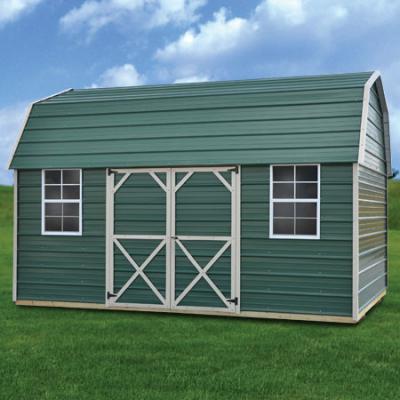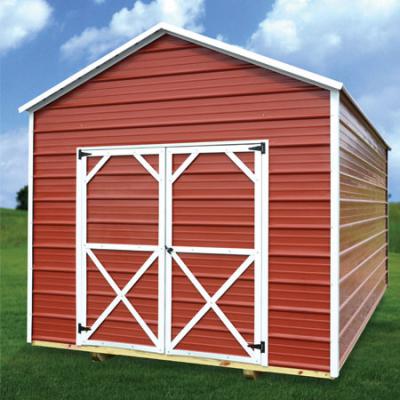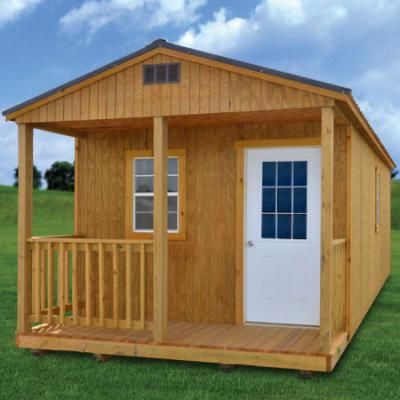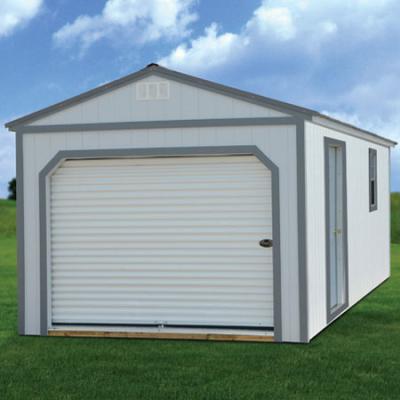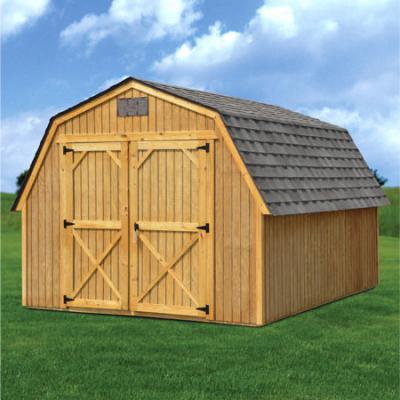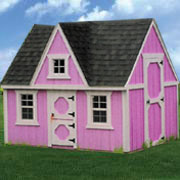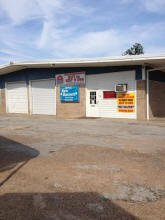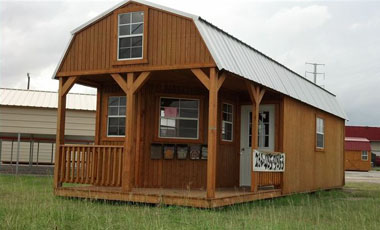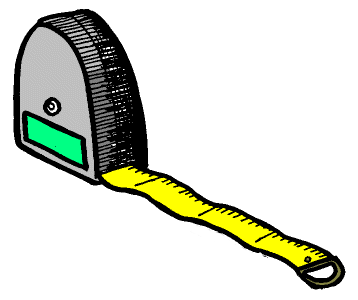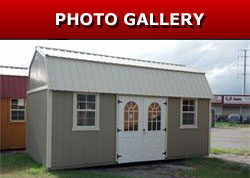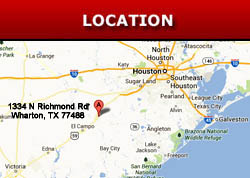Wharton Portable Buildings West Columbia, Texas
West Columbia, Texas - City Website
|
In September 1836 Columbia, now known as West Columbia, became capital of the Republic of Texas. This took place with the removal of the ad interim government here from Velasco. After the election called by ad interim President David G. Burnet, the first permanent government of the Republic went into operation here in Columbia in October. Inaugurated were President Sam Houston and Vice-President Mirabeau B. Lamar. Under their leadership the first duly elected Congress convened and the first Constitution of the Republic was ratified. Citizens of this vicinity served the Republic. Henry Smith of nearby Brazoria prior of this time has been the first Anglo-American governor of Texas, in the 1835-36 Revolutionary provisional government. In President Houston's cabinet he was secretary of the treasury. Stephen F. Austin, colonizer and Father of Texas, was secretary of state; under the heavy demands of that office, his health broke and he died here on December 27, 1836. In April 1837 at the wish of President Houston, the seat of government was moved to more adequate quarters in the city of Houston.
The first duly elected Congress of
the Republic of Texas met at Columbia, the new capital,
October 3, 1836. The provisional government had been
forced to move many times after the Texans declared
their independence from Mexico on March 2, 1836 at
Washington on the Brazos. the temporary capital was
first established at Harrisburg on March 22, but in less
than a month the officials were forced leave to escape
Santa Anna's troops. The government fled to Galveston
just one day before Santa Anna arrived at Harrisburg to
burn it down, and in a few weeks moved again, this time
to Velasco. Facilities in both places were inadequate,
so in July, ad interim President David G.
Burnett called for a general election and ratification
of the constitution, and decreed that the first duly
elected legislature of the Republic of Texas would
convene at Columbia on the first Monday in October,
1836.
Columbia was chosen as the capital for two principal reasons - there were greater facilities available than in any other town at that time and the early newspaper the Telegraph and Texas Register was there. Columbia had served as a seat of justice for the municipality of Columbia under Mexico, and boasted a number of permanent buildings built while it was the seat of the courts, including a large hotel, offices and a few dwelling houses and log cabins. Two buildings served to house Congress and the principal offices of the government, and some officials and committees used adjacent log cabins. One of the buildings used by Congress was built by Capt. Henry S. Brown in 1832, serving as his family residence until his death in 1834. The other building used by Congress was a store built by Leman Kelsey in about 1833. The Kelsey building was destroyed by a storm in 1900. A state marker was placed near the original site by the Texas Centennial Committee in 1936. A replica of this Kelsey building was constructed in 1977.
The shed room to the rear
served as Stephen F. Austin's office while
he was Secretaryof State.
The first Congress accomplished much. They ratified the constitution, appointed committees, provided for the army and navy, protection from the Indians, created a judiciary, postal department, a land office and established a financial system. Housing continued to be a problem, so Congress voted to move the capital to Houston in 1837. |
West Columbia,
Texas Chamber of Commerce
| Area Historic Sites | |
|
Old Columbia Cemetery |
Site given by
Josiah H. Bell family out of their grant- the first grants deeded to one
of "old 300" in colony of Stephen F. Austin. Has a grave of many heroes
of Texas Revolution of 1836. Located
at 16th and Jackson St. |
|
Columbia United Methodist Church |
This congregation
traces its history to early Methodist missionary activity during Texas'
years as a Republic. In 1839 the Rev. Isaac L.G. Strickland was assigned
to the Brazoria circuit and organized a Methodist church in Columbia
(now West Columbia), an early capital of the Republic. Located at 315 S.
16th Street. |
|
Josiah H. Bell Home Site |
Josiah Hughes Bell, Brazoria County planter, founder of East and West Columbia, Texas. Also one of Stephen F. Austin's Old Three Hundred colonists was born on August 22, 1791, in South Carolina. Bell moved to what became known as Bell's Creek in January 1824. On this tract of 6,642 acres, was built the town of Columbia, first capital of the Republic of Texas. |
|
George McKinstry Home Site |
Stephen F. Austin died
at 12:30 p.m., December 27, 1856, at age 45, of pneumonia. A memorial
service was held at Judge George McKinstry’s home site, place of
Austin’s death. George McKinstry served as a member of Austin’s Colony
in 1829. Served as a soldier in the battle of Velasco. Served as a chief
of justice of Brazoria County in 1836. As well as delegate to the
General Convention of 1832. |
|
The plantation is
named for its first and last owners - Martin and Elizabeth Varner and
Ima Hogg and features a refurbished two-story Greek revival plantation
house built around 1835. Varner farmed sugar cane, corn and raised
livestock. On April 4, 1834, Varner sold his holdings in Brazoria County
to Columbus R. Patton, who developed the site into a successful sugar
plantation. The Galveston hurricane of 1900 blew down the sugarhouse and
many other buildings at the plantation, but the house survived, and in
1901 the property was sold to former Governor Hogg. visit: http://www.visitvarnerhoggplantation.com
Located at FM 2852. |
|
|
East Columbia- Main Street National Historic District |
East Columbia was founded by Josiah Hughes Bell in 1823. Originally named Bell's Landing, this site on the Brazos served as a supply depot for settlements on the river above. In 1824 Bell laid out the new town and named it Marion. In 1842, when Bell's settlement on the prairie became known as West Columbia, Marion was renamed East Columbia. |
|
A. Ayock-Crews Bed & Breakfast - The Aycock-Crews House was built in the late 1870's by a riverboat captain named Aycock. It is of Victorian architectural style and is currently operated as a Bed & Breakfast. www.AycockCrews.com Located at 520 CR 703. |
|
|
B. Aldridge-Smith Home- The Aldridge-Dance-Smith House is associated with several families who played important roles in the development of East Columbia as a regional trade center during the late 19th and 20th centuries. |
|
|
C. Travis-Smith House- Travis Logan Smith Sr. played a pivotal role in East Columbia's economic development during the late 19th century. Smith recognized the importance of the Brazos River to East Columbia's growth and prosperity. With his brother, John, and his brother-in-law, Branch T. Masterson, he organized the Columbia Transportation Company in 1885 to provide shipping services to the region. The firm owned a fleet of six steamboats used to transport cattle, cotton, and produce from East Columbia to markets in Galveston. Another ship, the Hiawatha, was a luxury steamer run by the company as a passenger liner. |
|
|
D. Tyler-Bryan-Weems Home- While the construction date of this house is unknown, it is estimated to date to the 1870's as it so closely resembles the T.L. Smith House, built in 1878 on an adjacent lot. According to oral history, a two-story house and a smaller one-story house stood at this site prior to 1900. |
|
|
E. ML Weems Home- Built on Front Street overlooking the Brazos about 1847 by Dr. Mason Locke Weems. This house is unusual because a raised cottage was built above a six-room basement that was used as a dispensary for Confederate troops during the Civil War. In addition to being a physician, Weems was a successful planter who was quite knowledgeable on a variety of agricultural subjects. Historically associated with the Weems family. |
|
|
F. Ammon
Underwood Home- One of the oldest frame houses still standing in
Texas. Built in 1835 the Ammon Underwood House is best known as the
50-year residences of Texas pioneer Ammon Underwood. Underwood came to
East Columbia in 1834 from Massachusetts. While Underwood lived in East
Columbia, he amassed a considerable fortune through the operation of two
large cotton plantations in Brazoria County. Underwood family occupied
the house for over 100 years. In the 1860's Underwood's plantation hands
labored to move the house away from the eroding banks of the Brazos
River. www.AmmonUnderwood.com
|
|
|
G. Sweeny- Waddy Cabin- Originally erected about 1850, this building historically served as a home of an enslaved African American family that worked on Sweeny's plantation. Mark and Larkin Waddy remained on the plantation after the abolition of slavery in Texas in 1865. The cabin continued to be occupied by members of the Waddy family until 1953. |
|
|
H. Dance Gun Shop- James H. Dance and his sons, George and David, moved to East Columbia in 1848 and established the only manufacturing operation in the community. The firm was most famous for manufacturing guns patterned after the Colt revolver that were praised by the Confederate Army for their accuracy. While George and David Dance operated the machine shop, James H. Dance was better known for his carpentry skills. The Dance machine shop was destroyed in the 1900 hurricane. |
|
|
Bell's Landing Business District |
A. Bell's Marker- By 1829 a community known as Bell's Landing or Marion, which became an important inland port, grew up around a landing Bell constructed near his home. Bell developed a sugar plantation along the creek's banks and subsequently laid out the two towns that came to be known as East Columbia and West Columbia. He built the area's first hotel in 1832, constructed a school, and as an innovative town planner provided garden plots for new residents. |
|
B. Carry A. Nation Hotel Site- Carry Nation, prohibitionist, daughter of George and Mary (Campbell) Moore, was born on November 25, 1846 and settled on a cotton plantation on the San Bernard River near Houston. Failing to make the plantation a success, Carry supported the family by managing a hotel in Columbia. The eventual Sale of the plantation enabled them to buy a hotel in Richmond, which Carry ran with sporadic assistance from her husband, who practiced law and corresponded for the Houston Post. |
|
|
|
|
|
Bethel Presbyterian Church |
Established in 1840, Bethel is the third oldest Presbyterian Church in
Texas. The present building was built in 1913 and is famous for it’s
beautiful, locally made stained glass windows. P.O.
BOX 817 ; East Columbia, TX 77486 ; (979) 345-3717 |
|
Nash- Wright House |
One of the oldest houses surviving in Stephen F. Austin colony town of Bell's Landing (East Columbia). Early part of this house was built about 1847 on cedar pole framing by George Lewis Nash. |
|
Sugar Mill at Byrnum-Mills Plantation |
The Mills brothers were among the most successful cotton and sugar producers in Texas. Their four Brazoria County plantations (Lowwood, Bynum, Palo Alto and Warren) are now the site of the Bar X land development. Remnants of the old Byrnum sugar mill remain. |
|
Bailey's Prairie |
Established in 1818 as an individual claim by James Briton Bailey, a later member of Austin's colony. Born in 1779, Bailey was tall, fearless, and of Irish stock. Pioneer Texas noted for his courage, integrity, and eccentric behavior. At his request he was buried standing up, facing west, his gun at his side so no one could look down on him, even in death. His restless ghost is said to walk this prairie. |
|
Replica of the First Capitol |
About 1833 Leman Kelsey built a story and a half clapboard structure near this location. When Columbia became capital of the Republic of Texas in 1836, the building was one of two, which housed the newly formed government. The first Republic of Texas Congress convened in Columbia. Here Sam Houston took office as president and Stephen F. Austin as secretary of state. In 1837 the government moved to Houston. The 1900 storm destroyed the original capital. The replica at this site was built in 1976-77. |
|
It is only fitting that a historical museum be located at
the site of the First Capitol of the Republic of Texas, established in
Columbia 1836. The mission of the museum is to bring better
understanding and appreciation of the rich history of West and East
Columbia to Brazoria County. The museum's goals are to collect,
preserve, and interpret the history of the area through the collection
and display of artifacts of the area's earliest beginnings. Exhibits
begin with the period when the city was the First Capitol and extend to
the present day. Numerous groups and individuals have given or loaned
artifacts for exhibition. Located at 247 E. Brazos Ave |
|
|
One of 5,300 built in 15 southern states
between 1917 and 1932 as part of an initiative by Sears, Roebuck & Co.
President Julius Rosenwald and black educator Booker T. Washington to
build schools in the rural south for black students. |
|
|
Nash Prairie
|
On 300 acres of pristine coastal prairie
grow almost 300 identified plant species, with three being considered
rare, and one thought to have been extinct in Texas! It is located not
far from where Santa Anna was kept prisoner after his capture at the
Battle of San Jacinto. |
|
“The Capitol of
|
This is
a unique park dedicated to the period in history – The Republic of
Texas. Congress met in |

